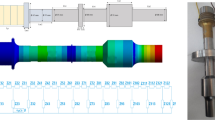Abstract
The results of ultrasonic action to the substances have been presented. It is examined, the correlation between the electrical parameters of ultrasonic equipment and acoustic performances of the ultrasonic field in treating the medium, the efficiency of ultrasonic technological facility, and the peculiarities of oscillations introduced into the load under cavitation development. The correlation between the acoustic powers of oscillations securing the needed level of cavitation and desired technological effect, and the electrical parameters of the ultrasonic facility, first of all, the power, is established. The peculiarities of cavitation development in liquids with different physical-chemical properties (including the molten low-melting metals) have been studied, and the acoustic power of oscillations introduced into the load under input variation of electric power to the generator has been also estimated.
Similar content being viewed by others
References
V. O. Abramov, O. V. Abramov, V. V. Artem’ev, et al., Power Ultrasound in Metallurgy and Mechanical Engineering, Ed. by O. V. Abramova and V. M. Prikhod’ko (Yanus-K, Moscow, 2006) [in Russian].
Chemistry with Utrasound, Ed. by T. Mason (Elsevier, New York, 1990; Mir, Moscow, 1993).
Yu. I. Kitagorodski, in Ultrasonic Technology (Metallurgiya, Moscow, 1974), pp. 220–267 [in Russian].
D. A. Gershgal and V. M. Fridman, Ultrasonic Technological Apparatus (Énergiya, Moscow, 1976) [in Russian].
Description of the Ultrasonic Generator UZG 3–4 Type (MRTZ Informational Sheet).
Description of the Magnetostriction Transformer PMS Type 15A-18 (MRTZInformation Sheet).
Description of the Ultrasonic Devices of the Branson Firm (Branson Informational Sheet).
Description of the Ultrasonic Devices of the Sonic and Material Firm (Sonic and Material Informational Sheet).
Description of the Ultrasonic Devices of the Martin Walter Firm (Martin Walter Informational Sheet).
Description of the Ultrasonic Devices of the Dr. Hischler Firm (Dr. Hischler Informational Sheet).
Description of the Ultrasonic Devices of the Telsonic Firm (Telsonic Informational Sheet).
L. D. Rozenberg, Physics and Technique of Power Ultrasound, in 3 vols. (Nauka, Moscow, 1967, 1968, 1970) [in Russian].
A. Crowford, Industrial Ultrasonics (Loughborough Univ. of Technology, 1969).
K. Suslick, Ultrasound: its Chemical, Physical, and Biological Effects (VCH, 1988).
U. Neis, Application of Power Ultrasonic in Physical and Chemical Processing (Propeg, 2001).
W. L. Nyborg, Acoustical Streaming, Physical Acoustics (Academic Press, 1965), Vol. 2, pp. 109–176.
L. K. Zarembo, in High Intensity Ultrasonic Fields (Nauka, Moscow, 1968; Plenum Press, New York, 1971).
Z. A. Gol’dberg, in High Intensity Ultrasonic Fields (Nauka, Moscow, 1968; Plenum Press, New York, 1971).
A. D. Pernik, Cavitation Problems (Sudostroenie, Moscow, 1966) [in Russian].
R. Knapp, J. Daily, and F. Hammit, Cavitation (McGraw Hill, New York, 1970; Mir, Moscow, 1974).
G. V. Flynn, in Methods and Instruments for Ultrasonic Study (Mir, Moscow, 1971), pp. 127–189 [in Russian].
V. A. Akulichev, in High Intensity Ultrasonic Fields (Nauka, Moscow, 1968; Plenum Press, New York, 1971).
L. Crum, Phys. Today (1994), pp. 22–29.
W. Lauterborn, Cavitation. Encyclopedia of Acoustics (Wiley, New York, 1997).
W. Lauterborn, J. Acoust. Soc. Am. 88, 1061 (1990).
B. Langenecker, Rev. Sci. Industr. 37, 103 (1969).
E. G. Shvidkovski, N. A. Tyapunina, and E. P. Belozerova, Kristallografiya 7, 473 (1962) [Sov. Phys. Crystallogr. 7, 378 (1962)].
I. G. Polotski and D. I. Ovsienko, Fiz. Met. Metalloved. 21, 744 (1966).
V. F. Kazantsev, Vopr. Sudostroen., Ser. Akust. 12, 44 (1979).
A. V. Kulemin, Ultrasound and Diffusion in Metals (Metallurgiya, Moscow, 1978) [in Russian].
Ultrasonic Technology, Ed. by B. A. Agranat (Metallurgiya, 1974) [in Russian].
O. Abramov, High Intensity Ultrasounds, Theory and Industrial Application (Gordon and Breach, 1998).
E. Kikuchi, Ultrasonic Transducers (Corona, Tokyo, 1969; Mir, Moscow, 1972).
I. I. Teumin, Techn. Inform. Byull. OKB of Ultrasonic and High-Frequency Devices 4, 2 (1960).
V. F. Kazantsev, Design Calculation of Ultrasonic Transducers for Technological Equipment (Mashinostroenie, Moscow, 1980) [in Russian].
H. Nodveld, Acoustica 4, 466 (1954).
A. Perkins, Ultrasonics 4, 193 (1964).
I. I. Teumin, Ultrasonic Oscillation Systems (Mashgiz, Moscow, 1960) [in Russian].
I. I. Teumin, Ultrasonic Waveguide Emission Systems (Mashgiz, Moscow, 1963) [in Russian].
I. I. Teumin, in Origins of Powerful Ultrasound (Nauka, Moscow, 1967), pp. 207–287 [in Russian].
A. E. Kolesnikov, Ultrasonic Measurements (Izd-vo Standartov, Moscow, 1970) [in Russian].
M. A. Margulis and I. M. Margulis, in Proc. of the 8th Conf. of Eur. Soc. of Sonochemistry, Villasimus, Italy, 2002, p. 26.
I. M. Margulis, Akust. Zh. 51, 698 (2005) [Acoust. Phys. 51, 695 (2005)].
O. V. Abramov, V. O. Abramov, O. M. Gradov, S. I. Nikitneko, Ph. Moisy, and P. Blanc, in Proc. of UIA (USA, 2000), p. 21.
T. Mason, Advances in Sonochemistry, in 4 vols. (JAI Press, 1989, 1991, 1993, 1996).
Yu. S. Astashkin and O. V. Abramov, in Electrophysical and Electrochemical Processing Methods (Mashprom, 1972), Vol. 9, pp. 13–18 [in Russian].
Author information
Authors and Affiliations
Corresponding author
Additional information
Original Russian Text © O.V. Abramov, V.O. Abramov, M.S. Mullakaev, V.V. Artem’ev, 2009, published in Akusticheskiĭ Zhurnal, 2009, Vol. 55, No. 6, pp. 828–844.
Rights and permissions
About this article
Cite this article
Abramov, O.V., Abramov, V.O., Mullakaev, M.S. et al. The efficiency of ultrasonic oscillations transfer into the load. Acoust. Phys. 55, 894–909 (2009). https://doi.org/10.1134/S1063771009060244
Received:
Published:
Issue Date:
DOI: https://doi.org/10.1134/S1063771009060244




